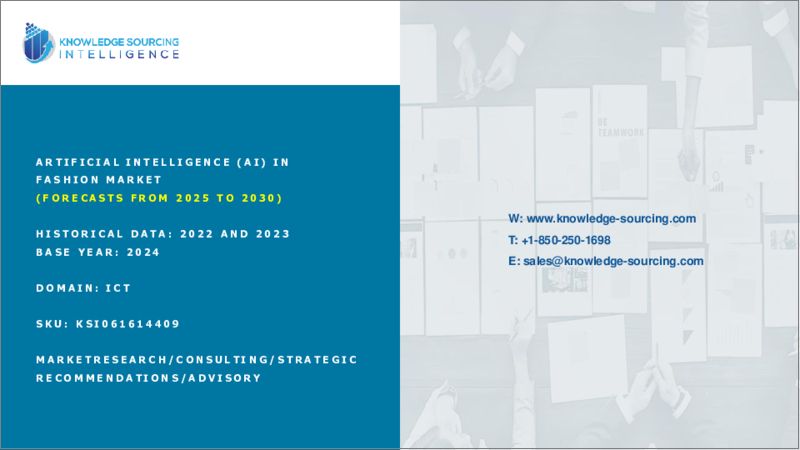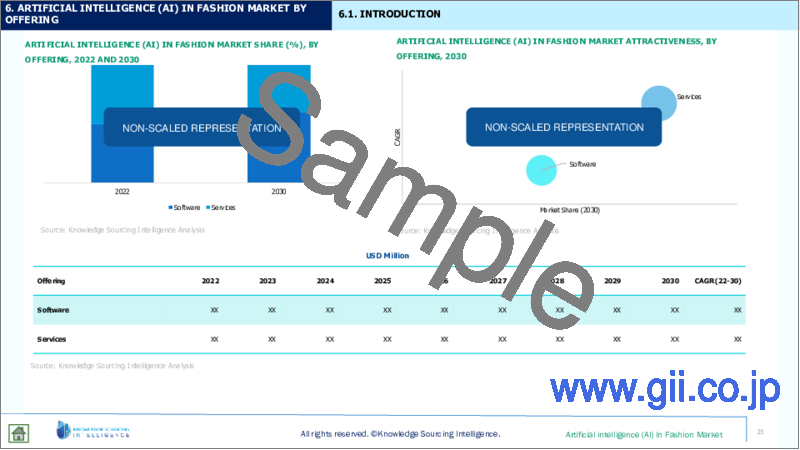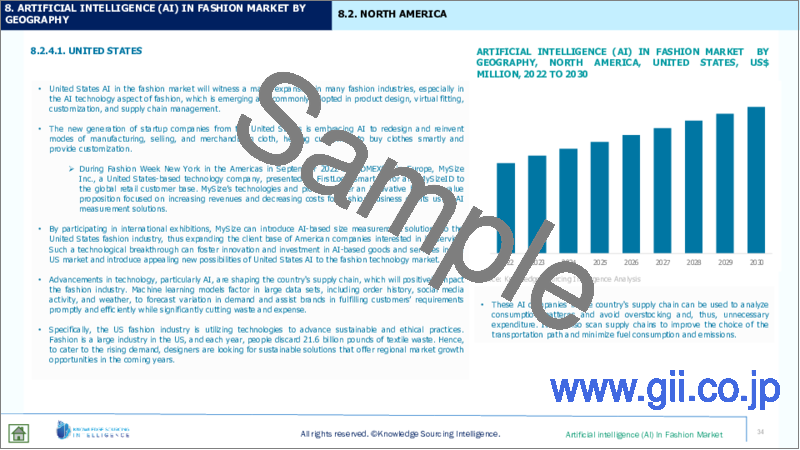|
|
市場調査レポート
商品コード
1574134
ファッションにおける人工知能(AI)市場:2024年~2029年の予測Artificial Intelligence (AI) in Fashion Market - Forecasts from 2024 to 2029 |
||||||
カスタマイズ可能
|
|||||||
| ファッションにおける人工知能(AI)市場:2024年~2029年の予測 |
|
出版日: 2024年09月24日
発行: Knowledge Sourcing Intelligence
ページ情報: 英文 155 Pages
納期: 即日から翌営業日
|
全表示
- 概要
- 目次
ファッションにおける人工知能(AI)市場は、2024年の17億5,220万5,000米ドルから、2029年までには99億2,591万3,000米ドルへと、CAGR41.46%の成長が見込まれています。
AIの導入は、ファッション・ビジネスのいくつかの分野の成長に影響を与える重要な要因の一つです。AI技術は、データ分析を用いてパーソナライズされたショッピング体験を通じて、顧客の満足度とロイヤルティを高めます。AR&AIバーチャル試着・試着室ソリューションは、顧客のショッピング体験を向上させ、返品時間を短縮し、高い確実性を確保します。業界は今後も、サプライチェーンの最適化、ダイナミックプライシング、不正検知、動向調査、持続可能性に焦点を当てた新商品イノベーションから恩恵を受けると思われます。これらのイニシアチブは、安全な取引と業務効率を改善することで、急速に変化する顧客の期待に対応するのに役立つと思われます。ファッション市場は、AIの採用がこの業界を牽引する上でより広範な影響を及ぼすものの、基準も向上する流動的な環境です。
さらに、2023年4月のUSCCのデータによると、より多くの人々がオンラインで買い物をし、ソーシャルメディアによって購買決定に影響を受けると予想されています。2022年までに、ファストファッション・ビジネスの売上は1,064億米ドルに達すると予想されています。同ソースによると、集中化された高速サプライチェーンを利用し、消費者のアプリでの検索履歴を活用することで、Sheinは米国で大きな市場シェアを獲得し、ZARAやH&Mといったライバルと競合しています。他のファッション関連の中国企業も、このAIビジネスモデルに関心を寄せています。
ファッションにおけるAI市場の促進要因:
- ファッション業界におけるAIの人気の高まりは、市場成長の一助になると推測されます。
独自のスタイル選好や体験を求めるこだわりの強い顧客が増え、ファッションにおけるAIの導入が期待されます。AI主導のレコメンデーション、インフルエンサーのインスピレーション、カスタマイズ可能な製品がこのシフトの割合を高めています。今の時代は、一人一人に合ったものを考えるよりも、個人を重視するようになっています。そのため、消費者の要求はパーソナライゼーションに傾き、ブランドは革新的なテクノロジーを採用することで対応しています。これは、人々が関わる業界とのつながり方に大きな変化が起きていることを示しており、また、データ・インサイトを通じて、進歩のための意見を深く提供しています。
AIはこれらの目的を大きく促進するものであり、政府の公式報告書は英国がAI技術の開発、テスト、利用において世界をリードする場所として位置づけられることを保証するものです。2023年8月3日の英国政府の更新データによると、最近発表されたAI技術ミッション基金への1億1,000万ポンド、新しいAI調査リソースの創設への9億ポンド、大規模なAIモデルを実行できるエクサスケール・スーパーコンピューターの設立への800万ポンドについて示されています。さらに、1億1,700万ポンドの資金と800万ポンドのAIグローバルタレントネットワークによって支えられており、AI研究者に数百人の博士号を授与するために活用される予定です。
ファッションにおけるAI市場の地理的展望
- 北米地域は、ファッション分野におけるAI市場シェアのかなりの部分を占めると予想されます。
最近、IBMやMicrosoft CorporationのようなAI企業が国内に増えているおかげで、ファッションにおけるAI市場は、特にファッション産業が飛躍的な成長を遂げている北米で、驚異的に繁栄しています。さらに、ソーシャルメディアの浸透が進み、国内でのローカルビジネスの採用が進んでいることも、想定される時間枠での市場波及に寄与しています。さらに、ファッションは市場をカバーする最も急成長している部門の1つであり、この地域のあらゆる部門で企業がますますAIに対応できるようにすることに、より広く焦点が当てられています。
ファッション業界におけるAI市場の新製品採用です。例えば、2023年6月、Googleはバーチャル試着を可能にする新しいAIショッピング機能を発表しました。これは新しい生成AIモデルで、1枚のドレスの画像をもとに、さまざまなポーズをとった実際のモデルに対して、そのドレスがどのようにドレープし、折り畳まれ、肌に密着し、伸び、シワになるかを示すことができます。6月の時点では、これはアメリカ国内の買い物客のみが利用可能で、女性買い物客は、Anthropologie、Everlane、H&M、LOFTといったブランドを含むGoogle全体の女性用トップスを試すことができました。それゆえ、ブランドがファッション業界におけるAIの真の重要性を公表しており、企業の注目度が高まっていることと相まって、予測期間中の市場成長に優位性をもたらすと予想されます。
さらに、国内ではAI産業への投資が増加しています。例えば、2023年5月、米国国立科学財団は、他の連邦政府機関、高等教育機関、その他の利害関係者と共同で、1億4,000万米ドルの投資を発表しました。この投資により、国内に7つの国立人工知能研究機関(AI Institutes)が新設される予定です。
本レポートを購入する理由
- 洞察に満ちた分析:顧客セグメント、政府政策と社会経済的要因、消費者の選好、産業分野、その他のサブセグメントに焦点を当て、主要地域と新興地域をカバーする詳細な市場洞察を得ることができます。
- 競合情勢:世界の主要企業が採用している戦略的作戦を理解し、適切な戦略による市場浸透の可能性を把握します。
- 市場促進要因と今後の動向:ダイナミックな要因と極めて重要な市場動向、そしてそれらが今後の市場開拓をどのように形成していくかを探ります。
- 実行可能な提言:ダイナミックな環境の中で、新たなビジネスストリームと収益を発掘するための戦略的決断を下すために、洞察を活用します。
- 幅広い読者に対応:新興企業、研究機関、コンサルタント、中小企業、大企業にとって有益で費用対効果に優れています。
企業は当社のレポートをどのような目的で利用していますか?
業界および市場考察、事業機会評価、製品需要予測、市場参入戦略、地理的拡大、設備投資決定、規制の枠組みと影響、新製品開拓、競合の影響
調査範囲
- 過去データ・予測、2022年~2029年
- 成長機会、課題、サプライチェーン展望、規制枠組み、顧客行動、動向分析
- 競合の市況、戦略、市場シェア分析
- 各国を含むセグメントと地域の収益成長と予測評価
- 企業プロファイル(戦略、製品、財務情報、主要な発展など)
目次
第1章 イントロダクション
- 市場概要
- 市場の定義
- 調査範囲
- 市場セグメンテーション
- 通貨
- 前提条件
- 基準年と予測年のタイムライン
- 利害関係者にとっての主要なメリット
第2章 調査手法
- 調査デザイン
- 調査プロセス
第3章 エグゼクティブサマリー
- 主要な調査結果
第4章 市場力学
- 市場促進要因
- 市場抑制要因
- ポーターのファイブフォース分析
- 業界バリューチェーン分析
- アナリストビュー
第5章 ファッションにおけるAI市場:用途別
- イントロダクション
- 設計
- 動向予測
- 在庫管理
- 返品処理
- カスタマーサポート
- その他
第6章 ファッションにおけるAI市場:オファリング別
- イントロダクション
- ソフトウェア
- サービス
第7章 ファッションにおけるAI市場:技術別
- イントロダクション
- 機械学習
- ロボティックプロセスオートメーション
- コンピュータビジョン
- その他
第8章 ファッションにおけるAI市場:地域別
- イントロダクション
- 北米
- 用途別
- オファリング別
- 技術別
- 国別
- 南米
- 用途別
- オファリング別
- 技術別
- 国別
- 欧州
- 用途別
- オファリング別
- 技術別
- 国別
- 中東・アフリカ
- 用途別
- オファリング別
- 技術別
- 国別
- アジア太平洋
- 用途別
- オファリング別
- 技術別
- 国別
第9章 競合環境と分析
- 主要企業と戦略分析
- 市場シェア分析
- 合併、買収、合意、コラボレーション
- 競合ダッシュボード
第10章 企業プロファイル
- Microsoft Corporation
- Amazon Web Services Inc.
- IBM Corporation
- Koninklijke Philips N.V
- Stylumia Intelligence Technology Pvt. Ltd.
- LALALAND
- True Fit Corporation
- Stitch Fix, Inc.
- ZMO.AI
- Zalando SE
Artificial intelligence (AI) in the fashion market is expected to grow at a CAGR of 41.46% from US$1,752.205 million in 2024 to US$9,925.913 million by 2029.
The incorporation of AI is one of the significant factors influencing the growth of several segments of the fashion business. AI technology boosts client satisfaction and loyalty via personalized shopping experiences using data analysis. AR & AI Virtual Try-On and Fitting Room solutions enhance the customer shopping experience, reducing returns times and ensuring a high level of certainty. The industry will continue to benefit from supply chain optimization, dynamic pricing, fraud detection, trend research, and new product innovation, focusing on sustainability. These initiatives will help address rapidly changing customer expectations by improving secure transactions and operational efficiency. The fashion market is a fluid environment that also improves standards, although the introduction of AI has a broader impact on driving this industry.
Furthermore, according to the USCC data of April 2023, it is anticipated that more people will be shopping online and being influenced in their buying decisions by social media. By 2022, the fast fashion business was expected to account for $106.4 billion in revenue. Using a centralized and fast-moving supply chain and leveraging the search histories of consumers on its app, Shein is taking major market share in the United States, competing with rivals such as Zara and H&M, according to the same source. Other fashion-related Chinese businesses are taking an interest in this AI business model.
AI IN FASHION MARKET DRIVERS:
- The increasing popularity of AI in the fashion industry is presumed to aid in market growth.
The adoption of AI is expected in fashion, with more picky customers seeking unique style preferences and experiences. AI-led recommendations, influencer inspiration, and customizable products are driving a growing proportion of this shift. Rather than thinking about a one-size-fits-all, current times focus more on the individual. As such, consumer demands lean towards personalization, and brands respond by adopting innovative technologies. It demonstrates a significant shift in how people connect with the industry they engage with and also deeply offers their input for advancements through data insights.
AI will largely facilitate these aims, and the white paper will ensure that the UK is positioning itself as the world's leading location for developing, testing, and using AI technology. As per the UK government's updated data of 3 August 2023, about the recent announcements of £110 million for our AI Tech Missions Fund, £900 million to create a new AI Research Resource, and £8 million to establish an exascale supercomputer that can run large AI models. This is all backed by a further £117 million of funding and an £8 million AI Global Talent Network, which would be utilized to award AI researchers hundreds of new PhDs.
AI In Fashion Market Geographical Outlook
- The North American region is expected to hold a substantial AI in fashion market share.
Recently, owing to the increasing number of AI companies in the country, like IBM and Microsoft Corporation, the market for AI in fashion is flourishing tremendously, especially in North America, where the fashion industry has witnessed exponential growth. Moreover, the increasing penetration of social media and the adoption of local businesses in the country are contributing towards market spillover for the envisaged time frame. Additionally, there is a more prevalent focus on ensuring that companies are increasingly AI-ready across all sectors of the area, with fashion being one of the fastest-growing divisions covering the market.
Introduction of new products in the market of AI in the fashion industry. For example, in June 2023, Google announced a new AI shopping feature that allows one to try on clothes virtually. This is a new generative AI model that can take one image of a dress and show how it will be draped, folded, clung to skin, stretched, and wrinkled on different real models in different poses. In June, this was only available for shoppers in the USA, and women shoppers could try women's tops across Google, including brands such as Anthropologie, Everlane, H&M, and LOFT. Hence, as the brands are releasing the real importance of AI in the fashion industry coupled with the increasing focus of companies, it is anticipated to provide an edge for market growth in the projected period.
Additionally, investments in the AI industry are increasing in the country. For instance, in May 2023, the U.S. National Science Foundation, in collaboration with other federal agencies, higher education institutes, and other stakeholders, announced an investment of US$140 million. This investment will establish seven new National Artificial Intelligence Research Institutes (AI Institutes) in the country.
Reasons for buying this report:-
- Insightful Analysis: Gain detailed market insights covering major as well as emerging geographical regions, focusing on customer segments, government policies and socio-economic factors, consumer preferences, industry verticals, other sub- segments.
- Competitive Landscape: Understand the strategic maneuvers employed by key players globally to understand possible market penetration with the correct strategy.
- Market Drivers & Future Trends: Explore the dynamic factors and pivotal market trends and how they will shape up future market developments.
- Actionable Recommendations: Utilize the insights to exercise strategic decision to uncover new business streams and revenues in a dynamic environment.
- Caters to a Wide Audience: Beneficial and cost-effective for startups, research institutions, consultants, SMEs, and large enterprises.
What do businesses use our reports for?
Industry and Market Insights, Opportunity Assessment, Product Demand Forecasting, Market Entry Strategy, Geographical Expansion, Capital Investment Decisions, Regulatory Framework & Implications, New Product Development, Competitive Intelligence
Report Coverage:
- Historical data & forecasts from 2022 to 2029
- Growth Opportunities, Challenges, Supply Chain Outlook, Regulatory Framework, Customer Behaviour, and Trend Analysis
- Competitive Positioning, Strategies, and Market Share Analysis
- Revenue Growth and Forecast Assessment of segments and regions including countries
- Company Profiling (Strategies, Products, Financial Information, and Key Developments among others)
Market Segmentation:
The AI In Fashion Market is segmented and analyzed as below:
By Application
- Deep Design
- Trend Forecasting
- Inventory Management
- Return Processing
- Customer Support
- Others
By Offering
- Software
- Services
By Technology
- Machine Learning
- Robotic Process Automation
- Computer Vision
- Others
By Geography
- North America
- USA
- Canada
- Mexico
- South America
- Brazil
- Argentina
- Others
- Europe
- United Kingdom
- Germany
- France
- Spain
- Others
- Middle East and Africa
- Saudi Arabia
- UAE
- Israel
- Others
- Asia Pacific
- China
- Japan
- India
- South Korea
- Indonesia
- Taiwan
- Others
TABLE OF CONTENTS
1. INTRODUCTION
- 1.1. Market Overview
- 1.2. Market Definition
- 1.3. Scope of the Study
- 1.4. Market Segmentation
- 1.5. Currency
- 1.6. Assumptions
- 1.7. Base and Forecast Years Timeline
- 1.8. Key benefits for the stakeholders
2. RESEARCH METHODOLOGY
- 2.1. Research Design
- 2.2. Research Process
3. EXECUTIVE SUMMARY
- 3.1. Key Findings
4. MARKET DYNAMICS
- 4.1. Market Drivers
- 4.2. Market Restraints
- 4.3. Porter's Five Forces Analysis
- 4.3.1. Bargaining Power of Suppliers
- 4.3.2. Bargaining Power of Buyers
- 4.3.3. Threat of New Entrants
- 4.3.4. Threat of Substitutes
- 4.3.5. Competitive Rivalry in the Industry
- 4.4. Industry Value Chain Analysis
- 4.5. Analyst View
5. AI IN FASHION MARKET BY APPLICATION
- 5.1. Introduction
- 5.2. Design
- 5.3. Trend Forecasting
- 5.4. Inventory Management
- 5.5. Return Processing
- 5.6. Customer Support
- 5.7. Others
6. AI IN FASHION MARKET BY OFFERING
- 6.1. Introduction
- 6.2. Software
- 6.3. Services
7. AI IN FASHION MARKET BY TECHNOLOGY
- 7.1. Introduction
- 7.2. Machine Learning
- 7.3. Robotic Process Automation
- 7.4. Computer Vision
- 7.5. Others
8. AI IN FASHION MARKET BY GEOGRAPHY
- 8.1. Introduction
- 8.2. North America
- 8.2.1. By Application
- 8.2.2. By Offering
- 8.2.3. By Technology
- 8.2.4. By Country
- 8.2.4.1. USA
- 8.2.4.2. Canada
- 8.2.4.3. Mexico
- 8.3. South America
- 8.3.1. By Application
- 8.3.2. By Offering
- 8.3.3. By Technology
- 8.3.4. By Country
- 8.3.4.1. Brazil
- 8.3.4.2. Argentina
- 8.3.4.3. Others
- 8.4. Europe
- 8.4.1. By Application
- 8.4.2. By Offering
- 8.4.3. By Technology
- 8.4.4. By Country
- 8.4.4.1. United Kingdom
- 8.4.4.2. Germany
- 8.4.4.3. France
- 8.4.4.4. Spain
- 8.4.4.5. Others
- 8.5. Middle East and Africa
- 8.5.1. By Application
- 8.5.2. By Offering
- 8.5.3. By Technology
- 8.5.4. By Country
- 8.5.4.1. Saudi Arabia
- 8.5.4.2. UAE
- 8.5.4.3. Israel
- 8.5.4.4. Others
- 8.6. Asia Pacific
- 8.6.1. By Application
- 8.6.2. By Offering
- 8.6.3. By Technology
- 8.6.4. By Country
- 8.6.4.1. China
- 8.6.4.2. Japan
- 8.6.4.3. India
- 8.6.4.4. South Korea
- 8.6.4.5. Indonesia
- 8.6.4.6. Taiwan
- 8.6.4.7. Others
9. COMPETITIVE ENVIRONMENT AND ANALYSIS
- 9.1. Major Players and Strategy Analysis
- 9.2. Market Share Analysis
- 9.3. Mergers, Acquisitions, Agreements, and Collaborations
- 9.4. Competitive Dashboard
10. COMPANY PROFILES
- 10.1. Microsoft Corporation
- 10.2. Amazon Web Services Inc.
- 10.3. IBM Corporation
- 10.4. Koninklijke Philips N.V
- 10.5. Stylumia Intelligence Technology Pvt. Ltd.
- 10.6. LALALAND
- 10.7. True Fit Corporation
- 10.8. Stitch Fix, Inc.
- 10.9. ZMO.AI
- 10.10. Zalando SE






